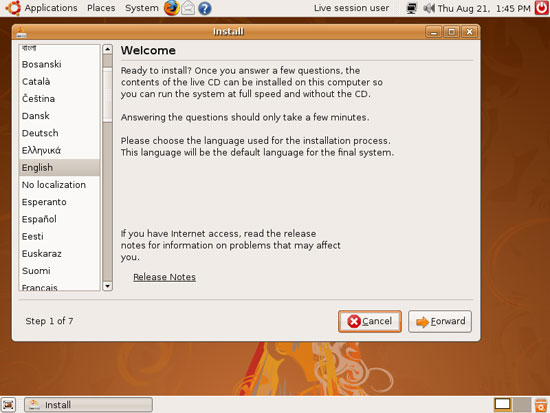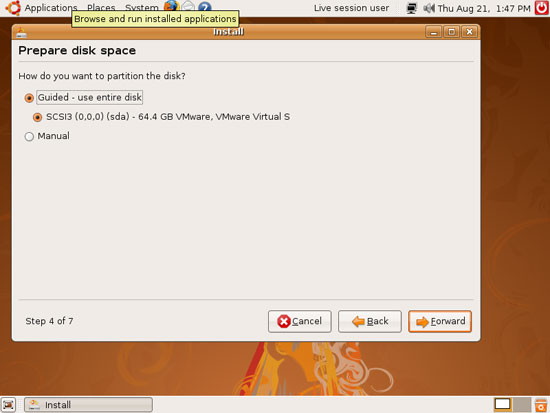Revisiting Linux Part 1: A Look at Ubuntu 8.04
by Ryan Smith on August 26, 2009 12:00 AM EST- Posted in
- Linux
Installation
In terms of difficulty, right up there with making a good GUI is making a good installer. History is riddled with bad OS installers, with pre-Vista Windows being the most well-known example. Text mode installers running on severely castrated operating systems reigned for far too long. Microsoft of course improved this with Windows Vista in 2006, but even as late as the end of 2007 they were still releasing new operating systems such as Windows Home Server that used a partial text mode installer.
The reason I bring this up is that good OS installers are still a relatively recent development in the PC space, which is all the more reason I am very impressed with Ubuntu’s installer. It’s the opposite of the above, and more.
Right now Ubuntu is the underdog in a Windows dominated world, and their installation & distribution strategies have thusly been based on this. It’s undoubtedly a smart choice, because if Ubuntu wiped out Windows like Windows does Ubuntu, it would be neigh impossible to get anyone to try it out since “try out” and “make it so you can’t boot Windows” are mutually incompatible. Ubuntu plays their position very well in a few different ways.
First and foremost, the Ubuntu installation CD is not just an installer, but a live CD. It’s a fully bootable and usable copy of Ubuntu that runs off of the CD and does not require any kind of installation. The limitations of this are obvious since you can’t install additional software and CD disc access times are more than an order of magnitude above that of a hard drive, but nevertheless it enables you to give Ubuntu a cursory glance to see how it works, without needing to install anything. Live CDs aren’t anything new for Linux as a whole, but it bears mentioning, it’s an excellent strategy for letting people try out the OS.

This also gives Ubuntu a backdoor in to Windows users’ computers because as a complete CD-bootable OS, it can be used to recover trashed Windows installations when the Windows recovery agent can’t get the job done. It can read NTFS drives out of the box, allowing users to back up anything they read to another drive, such as USB flash drive. It also has a pretty good graphical partition editor, GParted, for when worse comes to worse and it comes time to start formatting. Ubuntu Live CD is not a complete recovery kit in and of itself (e.g. it can’t clean malware infections, so it’s more of a tool of last resort) but it’s a tool that has a purpose and serves it well.
Better yet, once you decide that you want to try an installable version of Ubuntu, but don’t want to take the plunge of messing with partitions, Ubuntu has a solution for that too. Wubi, the Windows-based Ubuntu Installer, allows you to install Ubuntu as a flat-file on an existing NTFS partition. Ubuntu can then boot off of the flat file, having never touched a partition or the master boot record (instead inserting an Ubuntu entry in to Windows BCD). This brings all the advantages of moving up from a Live CD to an installable version of Ubuntu, but without the system changes and absolute commitment a full install entails. Wubi installations are also easily removable, which further drives home this point.
Now the catch with a Wubi installation is that it’s meant to be a halfway house between a Live CD and a full installation, and it’s not necessarily meant for full-time use. As a flat file inside of a NTFS partition, there are performance issues related to the lower performance of the NTFS-3G driver over raw hard drive access, along with both external fragmentation of the flat file and internal fragmentation inside of the flat file. An unclean shutdown also runs the slight risk of introducing corruption in to the flat file or the NTFS file system, something the Wubi documentation makes sure to point out. As such Wubi is a great way to try out Ubuntu, but a poor way to continue using it.
Finally, once you’ve decided to go the full distance, there’s the complete Ubuntu installation procedure. As we’ve previously mentioned Ubuntu is a live CD, so installing Ubuntu first entails booting up the live CD – this is in our experience a bit slower than booting up a pared down installation-only OS environment such as Vista’s Windows PE. It should be noted that although you can use GParted at this point to make space to install Ubuntu, this is something that’s better left in the hands of Windows and its own partition shrinking ability due to some gotchas in that Windows can move files around to make space when GParted can’t.
Once the installation procedure starts, it’s just 6 steps to install the OS: Language, Time Zone, Keyboard Layout, Installation Location, and the credentials for the initial account. Notably the installation procedure calls for 7 steps, but I’ve only ever encountered 6, step 6 is always skipped. This puts it somewhere behind Mac OS X (which is composed of picking a partition and installing, credentials are handled later) and well ahead of Windows since you don’t need a damn key.

The only thing about the Ubuntu installation procedure that ruffles my feathers is that it doesn’t do a very good job of simplifying the installation when you want to install on a new partition but it’s not the only empty partition. This is an artifact of how Linux handles its swapfile – while Windows and Mac OS X create a file on the same partition as the OS, Linux keeps its swapfile on a separate partition. There are some good reasons for doing this such as preventing fragmentation of the swapfile and always being able to place it after the OS (which puts it further out on the disk, for higher transfer rates) but the cost is ease of installation. Ubuntu’s easy installation modes are for when you want to install to a drive (and wipe away its contents in the process) or when you want to install in the largest empty chunk of unpartitioned space. Otherwise, you must play with GParted as part of the installation procedure.
This means the most efficient way to install Ubuntu if you aren’t installing on an entire disk or immediately have a single free chunk of space (and it’s the largest ) is to play with partitions ahead of time so that the area you wish to install to is the largest free area. It’s a roundabout way to install Ubuntu and can be particularly inconvenient if you’re setting up a fresh computer and intend to do more than just dual boot.

Once all of the steps are completed, Ubuntu begins installing and is over in a few minutes. Upon completion Ubuntu installs its bootloader of choice, GRUB, and quickly searches for other OS installations (primarily Windows) and adds those entries to the GRUB bootloader menu. When this is done, the customary reboot occurs and when the system comes back up you’re faced with the GRUB boot menu – you’re ready to use Ubuntu. Ubuntu doesn’t treat its first booting as anything special, and there are no welcome or registration screens to deal with(I’m looking at you, Apple). It boots up, and you can begin using it immediately. It’s refreshing, to say the least.
The actual amount of time required to install Ubuntu is only on the order of a few minutes, thanks in large part due to its dainty size. Ubuntu comes on a completely filled CD, weighing in at 700MB, while Windows Vista is on a DVD-5 at over 3GB, and Mac OS X is on a whopping DVD-9 at nearly 8GB. It’s the fast to download (not that you can download Windows/Mac OS X) and fast to install.
We’ll get to the applications in-depth in a bit, but I’d like to quickly touch on the default installation of Ubuntu. Inside that 700MB is not only the core components of the OS and a web browser, but the complete Open Office suite and Evolution email client too. You can literally install Ubuntu and do most common tasks without ever needing to install anything else beyond security and application updates. Consider the amount of time it takes to install Microsoft Office on a Windows machine or a Mac, and it’s that much more time saved. Canonical is getting the most out of the 700MB a CD can hold.










195 Comments
View All Comments
sheh - Thursday, August 27, 2009 - link
Also, it's "into", not "in to".Anyway, an interesting read. Thanks.
sheh - Thursday, August 27, 2009 - link
Also, it's "into", not "in to".Other than that, an interesting read. Thanks.
ssj4Gogeta - Thursday, August 27, 2009 - link
nevertheless is one "world"?:P
Ryan Smith - Wednesday, August 26, 2009 - link
Noted and fixed. Thank you.ClownPuncher - Wednesday, August 26, 2009 - link
Web browsing page - Ariel should read Arial when talking about fonts?pcfxer - Wednesday, August 26, 2009 - link
Ease of use of Ubuntu is superseded by PC-BSD and its PBI packages. PC-BSD also takes MUCH less time to install than Ubuntu.Souka - Wednesday, August 26, 2009 - link
I use PC-DOS 1.0aRuns very fast on my Core i7 setup, and I haven't even overclocked it yet.
ap90033 - Friday, August 28, 2009 - link
You probably can run more games in that than linux LOL...Penti - Tuesday, September 1, 2009 - link
You can run dosbox or dosemu in Linux just like in Windows...superfrie2 - Wednesday, August 26, 2009 - link
I'm not quite sure I agree with your criticism of .iso mounting in linux. The mount -o loop command is very easy to use after you've done a couple of times. In fact, I think it is far better than using D tools in windows because you don't have to worry about unclicking all the gay-ware it tries to get you to install.Also, I'm not sure I agree with your pseudo dislike for some forms CLI. CLI is far more powerful than what its GUI based copies tries to accomplish. As a matter of fact, the more I learn about linux's CLI, the less I use the GUI. I find myself only using the GUI for web browsing on a regular basis.
However, when looking at the linux GUI, compiz fusion is simply amazing. When I have a shitload of stuff open, compiz allows me to organize all of my windows and access them very efficiently. In fact, when I use windows for games, I feel handicapped.
The most interesting part your testing was that windows applications running under wine outperformed linux native applications. I look forward to hearing more about that aspect like you mentioned.